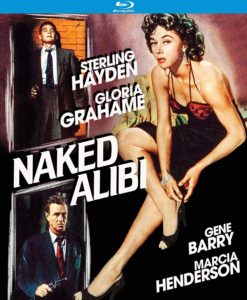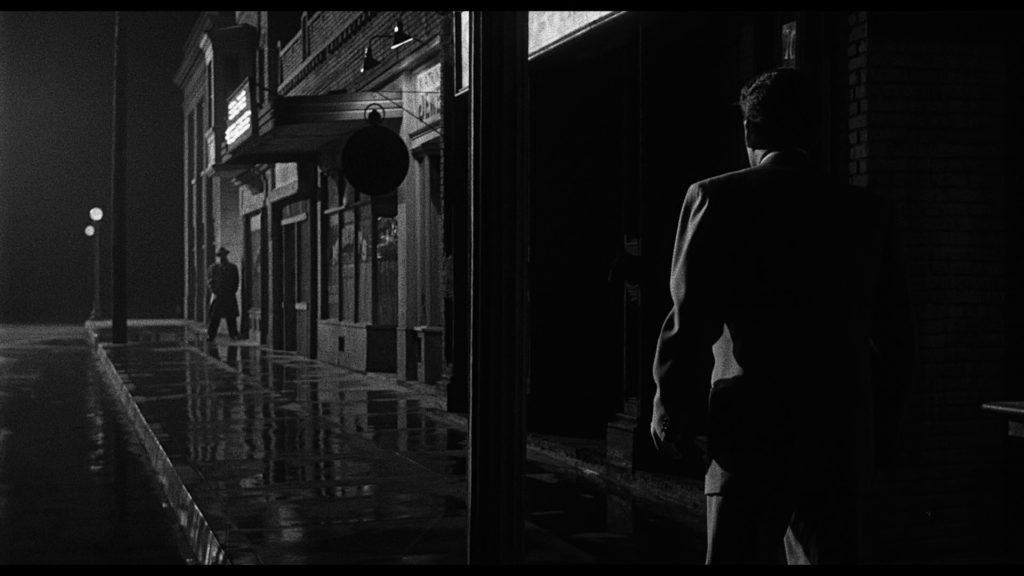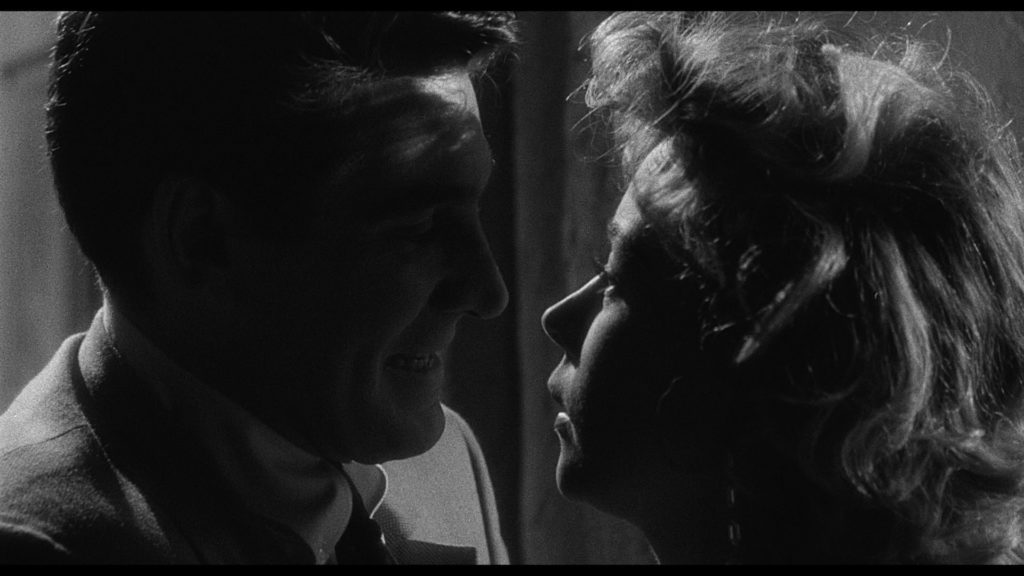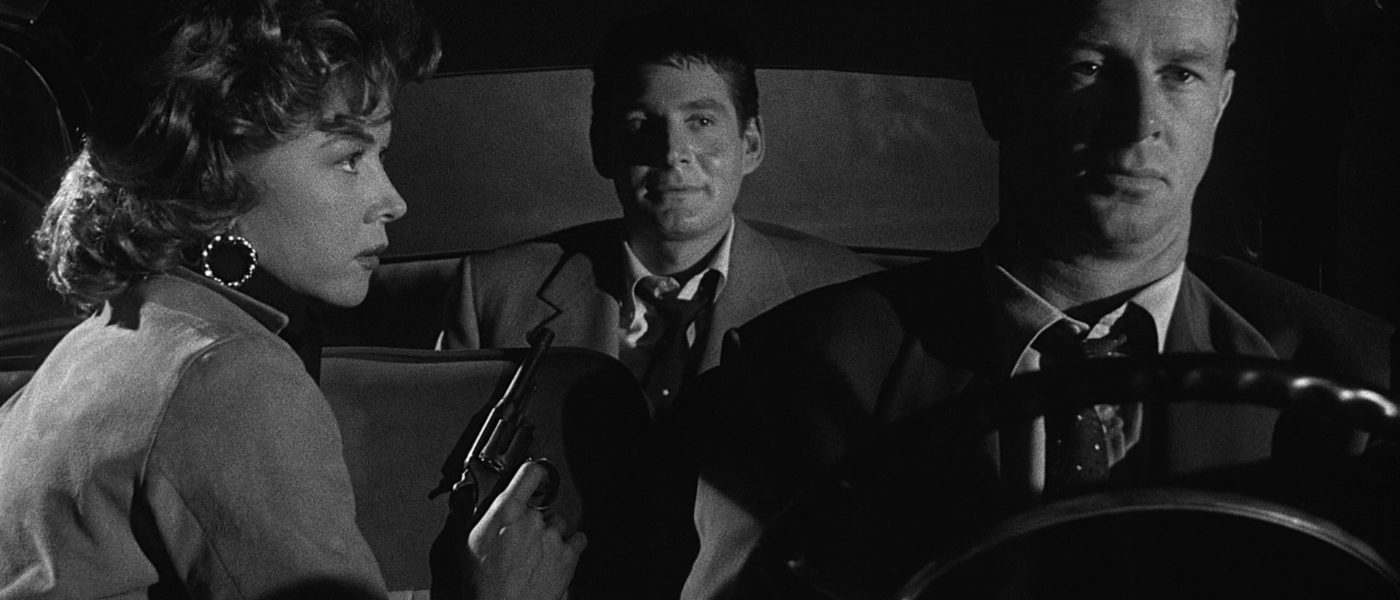Sterling Hayden, Gloria Grahame and Gene Barry Navigate Murky Morals and Even Murkier Locales in Classic Noir.
DIRECTED BY JERRY HOPPER/1954
BLU-RAY STREET DATE: NOVEMBER 5, 2019/KL STUDIO CLASSICS

Loaded with uncertainty and uncomfortably seething with brutality, 1954’s Naked Alibi starts with a jerk, builds to two jerks as main characters, then proceeds to jerk us around some more. That is, until such a time that it doesn’t.
Kino Lorber Studio Classics’ Blu-ray of Naked Alibi is a very worthwhile addition to any Film Noir library. Film historian Kat Ellinger chats her way through her audio commentary, an informative affair all the while. The look of this film, so key with its darkened tidy small-town American and later pulsing Mexican border-town adobe textures, is cultivated with great care. This black and white crime melodrama wears its shadowy morals quite well here.
Brick wall-like Sterling Hayden is a police chief with issues of violence. The City is on his case about his chronic mistreatment of suspects, but warnings won’t be enough for him to keep his job. The greasy perp that put him over the line is played by Gene Barry, something of an emotional chameleon. Barry, a venerable character actor and favorite of Sam Fuller, is perfect for the gearshifts this role requires.
We spend the first part of Naked Alibi thinking that Barry’s character, Al Willis,- a regular churchgoer, a family man and bakery owner- might be getting a raw deal. Without question, Hayden’s Chief Joe Conroy is fixated on pinning every major crime in town on him. Plus, there’s a certain pleasure taken by the Chief in punching Willis in the face and shoving him into walls. Yet, even in these early scenes, Willis exudes sliminess. Is his desperate alibi enough to keep him out of hot water?

(A tangent…) The first thing that happens in Universal International’s 1954 Film Noir is that a couple of guys scramble into the clock tower from Back to the Future. So, let’s look at Back to the Future for a minute. Though Universal’s standing town square backlot set had been in use for decades by the time Robert Zemeckis ran Michael J. Fox through Hill Valley’s central hub, it’s fair to say that until then, it was all but “invisible”. “Courthouse Square”, as it’s known, has been dressed and redressed for so many different productions that a definitive list seems to not exist. (It has its own Wikipedia entry, though its listing of films and TV shows to utilize it is far from complete). Back to the Future not only made the courthouse (redressed as the clock tower) iconic, the trilogy forced viewers to absorb its version of the town square geography. Consequently, when it turns up in a movie like Naked Alibi (that isn’t even included on the Wikipedia entry at the time of this writing), it’s immediately unintentionally familiar to many. It’s an eye-opening rabbit hole on the nature of film geography, iconography, and context. (End tangent)

The second-best thing about this film should be the film’s designated siren, Gloria Grahame. Grahame’s image, sexy yet super simplistic, dominates the poster, the advertising, and even Kat Ellinger’s audio commentary track on this Blu-ray. Grahame might be the biggest star in Naked Alibi, though she doesn’t turn up until about thirty minutes in. Accordingly, though, the movie all but stops for her character Mariana to perform a sultry club number, a lip-synched version of Cole Porter’s “Ace in the Hole”.
Yet even in this literally show-stopping performance, Grahame is choosing to push her character’s undeniable brokenness. It’s a choice that comes at the expense of the film’s momentum, something that perhaps a more precise director (Hopper was a studio-employed utilitarian) would’ve nipped in the bud. As a result, “Ace in the Hole” is kind of a slog exactly when it shouldn’t be. We learn the specifics of her character’s plight (which involves rather hallowing onscreen physical abuse) soon enough. Grahame all the while proves to be both a Gaga-like enigma and a stranded Woman in Trouble. Of course, the film sees fit to pit her in the middle of a love triangle- the last thing that Mariana needs, but the film needs it for her.
The best thing about Naked Alibi is its uncompromising commitment to keeping the viewer guessing. This, however, is only true if it’s first half. The good news is that by the time it reveals its characters’ true motives, it’s earned our attention. Naked Alibi works best as a straight-down-the-line, uninterrupted viewing, one with satisfying classic Noir aesthetic and vibe. Looking at it through a lens of contextualization, it lands in something of an uncomfortable if entirely valid place, as an open-ended examination of apparent postwar suppression of male id and angst. Conroy’s struggle with his own inner brutality is not something that is worked out. It could even be argued that the film is a lament that men like him aren’t allowed to operate that way anymore. Moral ambiguity, though, has its stark exposure for much of the very engaging Naked Alibi.


